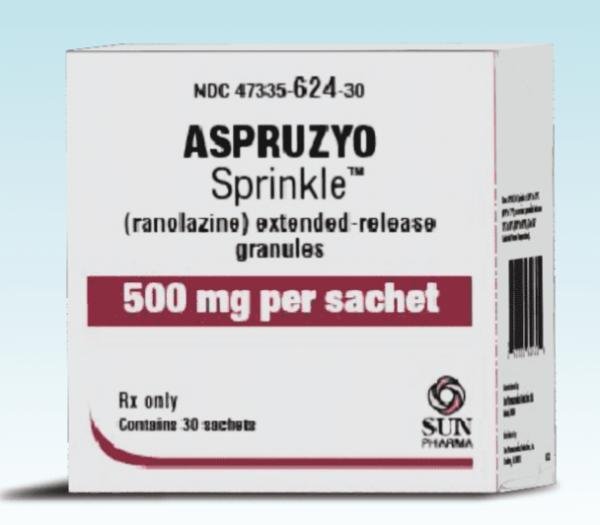Generic Aspruzyo Sprinkle Availability
Last updated on Dec 12, 2024.
Aspruzyo Sprinkle is a brand name of ranolazine, approved by the FDA in the following formulation(s):
ASPRUZYO SPRINKLE (ranolazine - granules, extended release;oral)
-
Manufacturer: SPIL
Approval date: February 28, 2022
Strength(s): 1GM (discontinued) [RLD], 500MG (discontinued) [RLD]
All of the above formulations have been discontinued.
Note: Fraudulent online pharmacies may attempt to sell an illegal generic version of Aspruzyo Sprinkle. These medications may be counterfeit and potentially unsafe. If you purchase medications online, be sure you are buying from a reputable and valid online pharmacy. Ask your health care provider for advice if you are unsure about the online purchase of any medication.
See also: Generic Drug FAQ.
Related patents
Patents are granted by the U.S. Patent and Trademark Office at any time during a drug's development and may include a wide range of claims.
-
Extended release multiparticulates of ranolazine
Patent 10,898,444
Issued: January 26, 2021
Inventor(s): Singh Harinder & Ahmad Shavej & Singh Romi B.
Assignee(s): Sun Pharmaceutical Industries LimitedThe present invention relates to an extended release multiparticulate composition comprising a plurality of discrete units, each discrete unit comprising ranolazine or a pharmaceutically acceptable salt thereof and one or more pharmaceutically acceptable excipients. The said multiparticulate composition is sprinkled onto soft foods or liquids for oral administration. Further, the multiparticulate composition is bioequivalent to the marketed extended release tablet. It further relates to a process of preparation of said multiparticulate composition and method of treatment of patients suffering from angina by administering said composition.
Patent expiration dates:
- January 24, 2038✓
- January 24, 2038
-
Extended release multiparticulates of ranolazine
Patent 11,510,878
Issued: November 29, 2022
Inventor(s): Singh Harinder & Ahmad Shavej & Singh Romi B.
Assignee(s): Sun Pharmaceutical Industries LimitedThe present invention relates to an extended release multiparticulate composition comprising a plurality of discrete units, each discrete unit comprising ranolazine or a pharmaceutically acceptable salt thereof and one or more pharmaceutically acceptable excipients. The said multiparticulate composition is sprinkled onto soft foods or liquids for oral administration. Further, the multiparticulate composition is bioequivalent to the marketed extended release tablet. It further relates to a process of preparation of said multiparticulate composition and method of treatment of patients suffering from angina by administering said composition.
Patent expiration dates:
- January 24, 2038✓
- January 24, 2038
More about Aspruzyo Sprinkle (ranolazine)
- Aspruzyo Sprinkle consumer information
- Check interactions
- Compare alternatives
- Pricing & coupons
- Drug images
- Side effects
- Dosage information
- During pregnancy
- Drug class: antianginal agents
- En español
Related treatment guides
Glossary
| Term | Definition |
|---|---|
| Drug Patent | A drug patent is assigned by the U.S. Patent and Trademark Office and assigns exclusive legal right to the patent holder to protect the proprietary chemical formulation. The patent assigns exclusive legal right to the inventor or patent holder, and may include entities such as the drug brand name, trademark, product dosage form, ingredient formulation, or manufacturing process A patent usually expires 20 years from the date of filing, but can be variable based on many factors, including development of new formulations of the original chemical, and patent infringement litigation. |
| Drug Exclusivity | Exclusivity is the sole marketing rights granted by the FDA to a manufacturer upon the approval of a drug and may run simultaneously with a patent. Exclusivity periods can run from 180 days to seven years depending upon the circumstance of the exclusivity grant. |
| RLD | A Reference Listed Drug (RLD) is an approved drug product to which new generic versions are compared to show that they are bioequivalent. A drug company seeking approval to market a generic equivalent must refer to the Reference Listed Drug in its Abbreviated New Drug Application (ANDA). By designating a single reference listed drug as the standard to which all generic versions must be shown to be bioequivalent, FDA hopes to avoid possible significant variations among generic drugs and their brand name counterpart. |
Further information
Always consult your healthcare provider to ensure the information displayed on this page applies to your personal circumstances.

